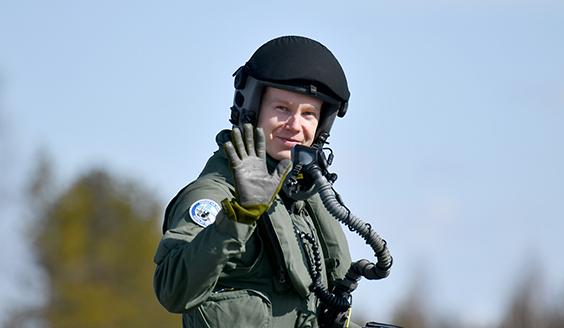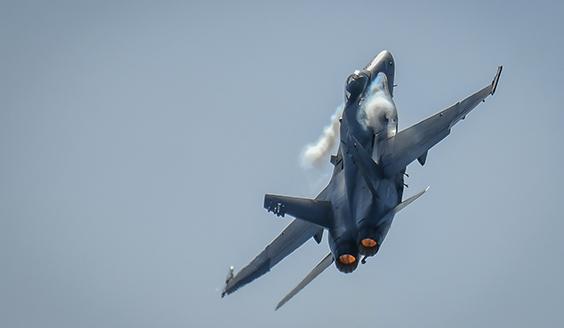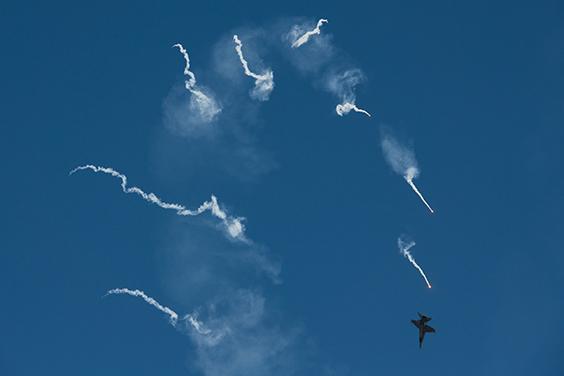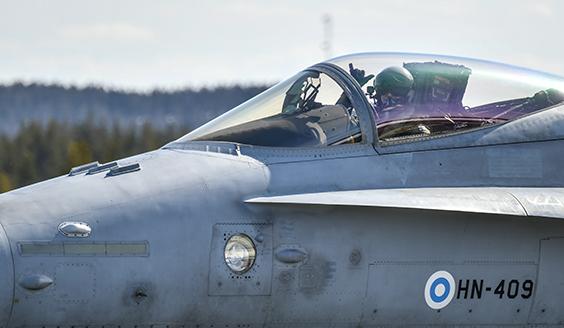“Some gutsy flying”
Presenting the Air Force Season 2021 F/A Hornet Display Pilot Captain Anssi Nieminen of Lapland Air Command.

Captain Anssi Nieminen serves as a flight instructor at Fighter Squadron 11. During his nine years at the controls of the Hornet, he has accumulated nearly 900 flight hours.
- My second job is to perform as the Hornet display pilot, which is one of the honorary roles in the Air Force. It feels incredible to get the opportunity to do it. Last year I was the stand-in Hornet display pilot.
This year the stand-in Hornet display pilot is Aleksi Ritvos from Karelia Air Command.
Anssi Nieminen, how did you become an Air Force Hornet pilot?
– Hailing from Kauhava in Southern Ostrobothnia, I was destined to become one. I spent my childhood marvelling at military aircraft in the air around Kauhava Air Base. Even as a little kid, I never imagined becoming anything else, other than a military pilot.
– Luckily, I succeeded to secure a place through the selection process in conscript service on the Air Force Pilot Reserve Officer Course in Tikkakoski. My service went well, and from there I then decided to apply to the Military Academy, which was the starting point of my career as an Air Force pilot. I gradually moved up from the Vinka training to the Hawk fighter jet training to learn the basics of air combat, and transitioned after that to training with the Hornet.
What kind of workplace is the Air Force and Lapland Air Command?
– The work environment at the Air Force and Lapland Air Command is excellent and working together with good people is enjoyable. The Air Force is a workplace that offers flexibility and takes employees into account.
What are your daily duties?
– My usual work day is spent teaching the secrets of flying a fighter in a simulator and an actual aircraft. We start our mornings together with a tasking meeting where the sorties of the day are introduced, flying partners assigned and the day’s weather reported.
– Before the flight, we have the briefing, or task briefing, where the sortie is mapped out in detail. After this we get into our flight gear, listen to the latest weather forecast and step to the planes. After the flight, there is a debriefing where we carefully go through the task and completed sortie. My other tasks include air exercise planning and, of course, performing as the display pilot.

How would you describe this year’s display sequence?
– This year’s display routine looks like its creator so the piloting is gutsy, even aggressive. The aircraft truly gets pushed to its limits in terms of manoeuvrability and what the Hornet can do in display flying and combat missions. The sequence is full of fun manoeuvres.
– The manoeuvres are flown both in low and high speed. In addition, there will be several changes from high-speed to low-speed combat manoeuvring. These showcase the Hornet's versatility and capability, or the thrust the engine can provide. A dynamic sequence is in the offing.

– Physically the most taxing manoeuvre is the 360-degree level turn at the speed of about 800 km/h with G-forces of 7,5-8 G taking their toll on your body, making you feel as much as eight times heavier. Flying at G-force speeds is fairly hard, your blood rushes down from your head to feet and your vison may blur, so you have to physically ensure that blood stays in your head and your vision remains clear.
– High angle of attack manoeuvring will be seen, for example in the foot barrel roll. You only use one foot in it - you push the controls with your foot so that the rudder turns the plane around relative to the air flow. In other words, the plane circles around its own centre of gravity almost horizontally, and the nose points to a different direction than to which the plane is proceeding. This is one of the favourite manoeuvres of the Hornet solo display fans, and for the pilots it’s one of the coolest tricks you can perform with the Hornet at an air show. The foot barrel roll is also known as the slippery barrel roll.
What do you have to consider to ensure a successful execution of a manoeuvre?
– Factoring in the weather and especially the wind is the hardest challenge in a sequence. Thus, we have different sequences planned for good, medium and bad weather.
What is the ideal display flying weather like?
– The ideal display flying weather would be sunny with a 30-degree below zero temperature and some humidity in the air that would condense above the wings forming a nice-looking cloud. But that’s just hard to come by, especially in summer. That said, it’s still terrific to fly a display sequence on a sunny summer day, with a good crowd watching.
How was this year’s display routine created?
– I’ve drafted it myself; though, with advice from the previous solo pilots. To put it all together was painstaking, especially in December and January, but now it works and I’m happy with it. Most of the training for display flights is carried out in a simulator where making mistakes is safe.
How do you prepare for a display sortie?
– I try to run through the sequence in a simulator right before the display. If it’s not possible, I fly the sequence as mental images in my brain a couple of times. Before stepping to the aircraft, I get the extra cameras in the cockpit ready and check the weather. I don’t have any big rituals before a display flight.

How has it felt being the main display pilot this year and the stand-in last year and not really being able to perform your solo?
– Of course, it’s a shame that many displays have been cancelled this year but I’m fine with it. I’ve still had the opportunity to fly practise display sorties on an aircraft, and although I’ve had no other audience than my work mates, the best thing about all this is to get the chance to fly. Unlike many performers, I don’t do this for a living.
– This season’s flight displays in Finland are mostly in August, starting with Kaivari 21 in Helsinki. I hope to be able to perform in as many events as possible, following the coronavirus recommendations.
Read more: Midnight Hawks’ display season continues under special circumstances
Follow the Air Force on social media
Facebook @Ilmavoimat
Twitter @FinnishAirForce
Instagram @ilmavoimat



